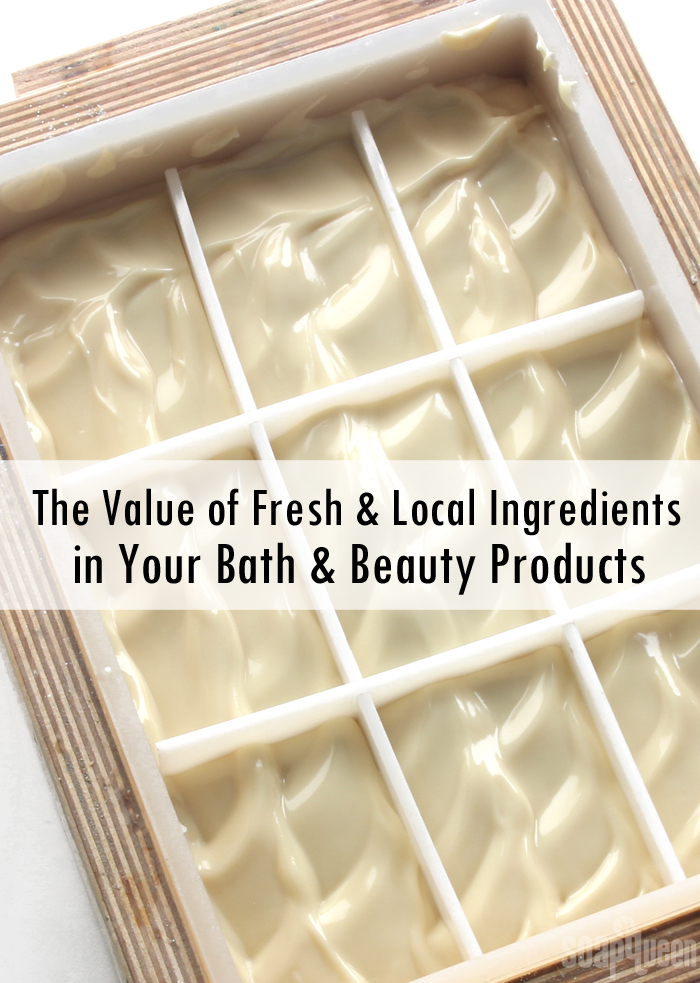
There are a variety of fresh ingredients that can be added to cold process soap, from honey to goat milk. They are a great way to make your soap stand out, and each ingredient adds special properties to the recipe. For example, goat milk adds skin-loving properties. Honey is great for boosting lather. Using fresh and local ingredients strengthens ties in your community and strengthens your brand identity.
If you sell your products, customers are delighted to know where the ingredients come from. This is especially true if the ingredients are from their local area! For example, here in Washington state, we are known for our coffee consumption and apple production. Adding locally roasted coffee or puree made from Washington apples in your soap is a way to showcase what the state has to offer.
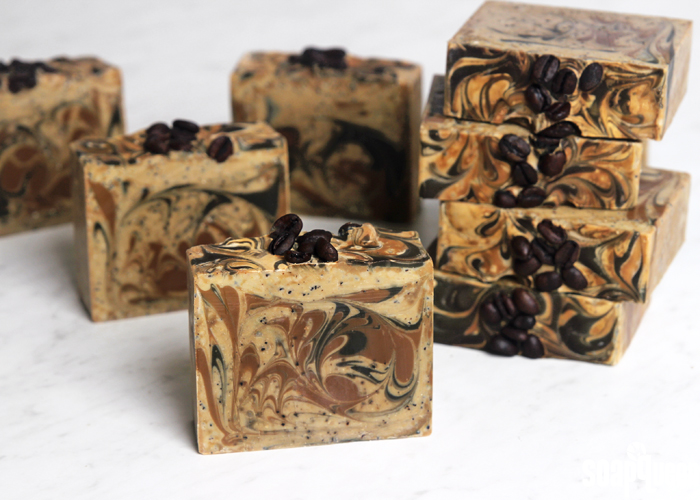 Locally roasted coffee is a great way to incorporate a local ingredient in your soap.
Locally roasted coffee is a great way to incorporate a local ingredient in your soap.
If you’re thinking about adding fresh and local ingredients to your soap, check out the blog posts below. They have information on how to work with alternative liquids, purees and honey, as well as recipes for each. Be on the lookout for recipes this week using local ingredients for more inspiration!
Alternative Liquids (milk, beer, tea, etc.)
In place of distilled water, liquids like milk, tea, coffee and alcoholic beverages can be used to make cold process soap. Using them in your recipe is a great way to highlight locally made goat milk or beer from a local brewery.
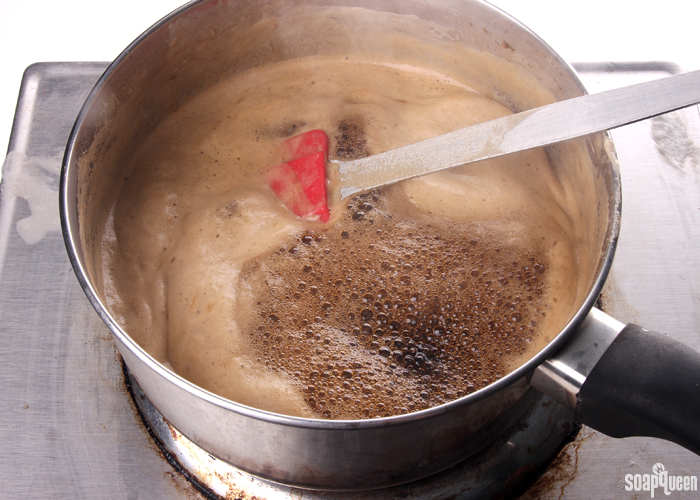
Informative Posts:
- How to Use Tea and Coffee in Soap
- How to Use Alcoholic Beverages in Cold Process Soap
- How to Add Lye to Milk
Tutorials:
- Goat Milk Soap Tutorial on Soap Queen TV
- Goat Milk & Oatmeal Cold Process Soap
- Creamy Cow Milk Cold Process Tutorial
- Buttermilk Bastille Baby Bar on Soap Queen TV
- Lime in the Coconut Milk Cold Process Tutorial
- Charcoal & Cedar Beer Cold Process Soap Tutorial
- Bramble Beer Soap Tutorial
- Black and Tan Beer Soap Tutorial
- Luck of the Green Beer Cold Process Tutorial
- Oatmeal Stout Cold Process Tutorial
- Exfoliating Green Tea Cold Process Bars
Fresh Ingredients & Purees
If a fruit or vegetable can be blended to a smooth texture, it can probably be used in cold process soap! When added to the batter, the puree goes through the saponification process along with the oils and lye solution. Fruit-based purees often add to a fluffy lather because of their natural sugar content. Additionally, many purees are great from a marketing standpoint and can add skin-loving benefits.

Informative posts:
Tutorials:
- Pumpkin Puree Cold Process Soap
- Pumpkin Spice Swirl Cold Process Soap
- Strawberries & Cream Cold Process Soap
- Avocado + Spearmint Cold Process Soap Tutorial
- Buttermilk Bastille Baby Bar on Soap Queen TV
- Lard and Loofah Cold Process Soap
Honey
Honey is a natural humectant, which means it helps draw moisture from the air to the skin. Adding honey to your products is a great way to support local beekeepers. Honey can overheat in soap, so give your soaping temperatures extra attention.
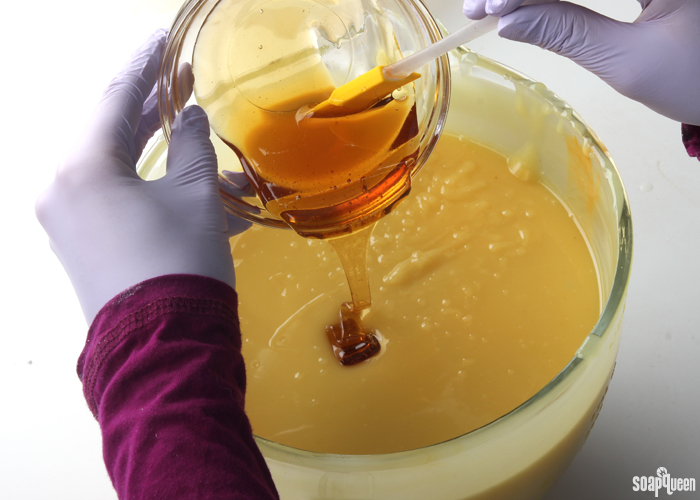
Informative Posts:
Tutorials:
Is there a fresh and local ingredient that you like incorporating into your products? Be on the lookout for several tutorials featuring ingredients from the Pacific Northwest.




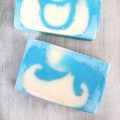
I am not able to buy fresh goat milk and was going to use canned. Would adding powdered goat milk help make it creamier and closer to fresh goat milk? If so, how much?
Adding goat milk powder can make it a bit thicker! I would recommend adding 1 teaspoon or so to the canned milk and mixing well. Too much may make it thick or gloopy, so add a small amount at a time until you get the consistency you like. 🙂
-Kelsey with Bramble Berry
Powdered goat milk: https://www.brambleberry.com/Powdered-Goat-Milk-P4933.aspx
Hello,
I am a bit worried. I was reading this blog the other day as I was seeking a recipe for rice milk soap. Somewhere through my reading I found a statement that cautions upon having goat milk for more than two months. That it should be used immediately by the consumer. I have goat milk that has been curing for more than two months because I have not had the time to make labels. Can you please expand upon your statement.
Thank you,
Ana
We do recommend using our goat milk powder within 2 months: https://www.brambleberry.com/Powdered-Goat-Milk-P4933.aspx
However, once the milk has been added to your soap, the shelf life is extended. That’s because the milk is turned into soap by the oils and lye. So, it has the same pH level as soap and will have the same shelf life. Learn more about working with milk here: http://www.soapqueen.com/bath-and-body-tutorials/tips-and-tricks/how-to-add-lye-to-milk-for-cold-process-soap/
And more about soap shelf life here: https://www.soapqueen.com/bath-and-body-tutorials/tips-and-tricks/shelf-life-bath-products-ingredients-rancidity-vs-mold/
-Kelsey with Bramble Berry
I was wondering, is it a good idea to ad the honew to the milk then freeze the milk, or better to add at trace?
We like to add the honey at trace because it does tend to speed up trace a bit. If your design doesn’t need a lot of time, you should be able to add the honey to the milk. You may want to make a small test batch just to be sure it works well though. 🙂
Learn more about working with honey here: https://www.soapqueen.com/bath-and-body-tutorials/tips-and-tricks/adding-honey-to-cold-process-soap-tips-tricks-recipe/
-Kelsey with Bramble Berry
We have a local honey producer and the honey I purchase from them goes to support a therapeutic riding center for kids and adults with special needs. I also purchase coffee from our local roaster. In addition, the local butcher gives me his beef fat and I then render that to make tallow. No waste! In return, I give him a free bar of soap or two when I make soap.
I love buying locally, and although I don’t sell my soap as of yet, this will be part of my marketing plan when and if I do decide to go ahead with it. Right now, friends and family get a 12 oz. bar whenever I make soap. 😁 I’m thinking of downsizing when I sell it to a 6 oz. thoughts? Or is the bigger size more unique? I happen to like it that big….
That’s awesome, it’s so amazing to support local beekeepers and butchers! Not to mention they probably really love the bars of soap. As for the bar size, you can embrace that as your niche if you like! Burly Stone makes big bars as part of their branding and it works really well: https://www.soapqueen.com/business/interview-burly-stone-soap-masculine-perspective/
Learn more about finding your niche here: https://www.soapqueen.com/business/niche-find-mine/
-Kelsey with Bramble Berry
Thanks for that link!!
I have tried fresh ginger and lemon in my cold process and there was so much liquid when I unmolded it! The soap shrunk a lot and the ash was terrible! I don’t know why that happened?
Lemon has a pH of around 2-3, while soap has has a pH of 9-10 (higher when the lye and oils are first combined). That means when the two are combined, the lemon can react with the soap and essentially create a really high superfat. How much lemon did you add to your soap, and at what stage? Let me know and I can help you troubleshoot!
-Kelsey with Bramble Berry
Great ideas! Love this.
How would it change with hot process soap and adding these kinds of ingredients? Good idea? Bad? Different technique/timing to the additions?
Thanks!
Adding heat to the equation can be tricky. For instance, milk can scorch when it gets too hot. Same with ingredients that contain sugar. What would you like to add to your hot process recipe? I can give you some tips. 🙂
-Kelsey with Bramble Berry
Can I jump in here? I have wondered this, too. I understand how dairy can be added to cold process and not spoil, but many people who do hot process add a little yogurt AT THE END of the cook (about 1T per pound of soap) to keep it fluid. I don’t understand how that will not spoil since it is added after the soap has cooked. Any thoughts or comments? I have wanted to try this.
Because the recipe is mostly done saponifying, adding the soap or yogurt at the end may not fully turn it into soap. There still may be that reaction happening so the milk will turn into soap, but it’s tough to say for sure. We like to use milk in cold process soap to be extra careful. 🙂
-Kelsey with Bramble Berry
Eric, I have used yogurt and coconut milk added at the end of the cook in HP and never had any problems. I add more than 1 tbs/ppo also. It works perfect, and never had any sign of spoiling or anything at all in those soaps even over a year later. I have also added purées at the end of cook (and sometimes at the beginning) and never had any problems at all. HTH
This is an intelligent and well thought out post that doesn’t say “buy everything from me only.” I like to buy soaping supplies locally (especially from small businesses) and I always do when I can. I can always find coconut and olive oils at local grocery stores and I always buy lye from the local hardware store where I actually worked about 25 years ago! All other supplies I can’t get locally, I buy from Brambleberry so my local stores AND Brambleberry benefit from a hobby I enjoy.
Absolutely, we’re big fans of supporting local businesses! 🙂
-Kelsey with Bramble Berry